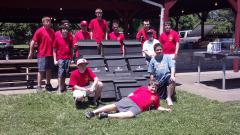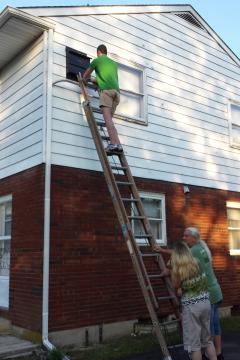Bats In Buildings
Information to help assess and address bat problems in the home.
 Little brown bats roosting between beams in a tractor barn. © Charles Hofer
Little brown bats roosting between beams in a tractor barn. © Charles Hofer
House Bats
Of the nine different bat species that live in New Jersey, little brown bats (Myotis lucifugus) and big brown bats (Eptesicus fuscus) are the most likely to roost in man-made structures like attics, barns, eaves, and church belfries. Nicknamed "house bats," these adaptable critters have found that buildings can provide a warm, safe, virtually permanent source of shelter. Their natural roosts - mainly dead or dying trees - are less abundant than they used to be, and tree roosts are also more vulnerable to weather, predators, and simply falling over. So buildings have become quite important as bat roosts.
 Zoom+ Big brown bats in an attic space. © Phil Wooldridge
Zoom+ Big brown bats in an attic space. © Phil Wooldridge
Bats are perfectly willing to share space with each other and often form large roosting groups during the spring and summer. These groups are called maternity colonies, and they consist only of mother bats and their young (adult male bats are more solitary). Females give birth to just one or two young each, in late May or early June. The mother bats must leave the roost to eat and drink every evening in order to produce enough nutritious milk for nursing. In fact, a nursing mother bat will eat her entire body weight in moths, beetles, mosquitoes, and other insects every night (be glad if you have bats in your backyard!). The youngsters are totally dependent on their mothers for about a month until they are strong enough to begin flying and foraging on their own.
By the end of July, all of the young bats are able to fly, and they leave the roost every evening with their mothers to practice hunting and swooping down for drinks of water. Between then and mid-October, the colonies disband and/or begin moving to their winter hibernation sites, which are mostly in underground caves and mines. However, we're learning that it may be quite common for big brown bats to stay all winter in an attic roost if the conditions are right.
How Do They Get In?
 Zoom+ A colony of 100 big brown bats roost in the attic of this building every summer. They enter and exit through a small gap where the eaves meet the chimney. Notice the dark "smudging" around the hole from the bats' body oils. © Phil Wooldridge
Zoom+ A colony of 100 big brown bats roost in the attic of this building every summer. They enter and exit through a small gap where the eaves meet the chimney. Notice the dark "smudging" around the hole from the bats' body oils. © Phil Wooldridge
Unlike rodents, bats are not capable of clawing or chewing their way into places. But they can squeeze through openings as small as a half-inch to gain access to a suitable roost. Bats often find their way in and out of buildings through openings in the eaves, ridge vents into the attic, the space between soffit boards where they join at the peak, or gaps or cracks where the chimney meets the house's siding or eaves. The older the building, the more likely it is to have such entry points and that bats have discovered them.
Bats also sometimes roost behind shutters, under roof tiles, slate, or shingles, beneath clapboard siding, or inside defunct chimneys. Most homeowners do not view this as a problem, as long as the bats aren't getting inside human living spaces.
Once a maternity colony finds a good roost, the bats will return to it every spring. The colony may continue to grow each year as the previous season's female offspring join in as mothers, though it seems that most colonies reach a leveling point. That leveling point may have to do with the amount of preferred roosting space (like close parallel beams and other dark nooks) inside the roost.
Are There Bats in My House?
Bats are shy, cautious animals, and their main strategy in life is to go unnoticed. They're active at night to thwart predators, and even their daytime roosts are dark and snug. Many people coexist with bats without ever knowing it. But there are signs of occupancy to look & listen for. If you know of a bat roost consider reporting it to us and being a part of Summer Bat Count! See our Summer Bat Count page for instructions and a reporting form.
Eviction and Bat-Proofing:
Bats are important to our environment and our economy, and they are protected by law in New Jersey. Myths and misconceptions about bats are rampant, so be sure to evaluate your situation fairly while deciding whether a colony can stay or go.
You may feel that your "house bats" have become a nuisance and decide to evict them. Whether you consult a professional or attempt to bat-proof your own home, state guidelines should be followed to ensure that bats are not injured, killed, or trapped in the process. Physically removing bats or poisoning bats is NOT legal and NOT effective. Fly traps and glue traps should NOT be used in places where bats may come in contact with them. Any pest controller who suggests these methods is not doing credible work.
New Jersey's "safe dates" for bat eviction are April 1-30 and August 1-October 15.
Bat Houses: Offer an Alternative
 Zoom+ Mitchell Fechter (back row center) and his friends from Scout Troop 87 in Mercer County built and donated bat houses to the Conserve Wildlife Foundation. Mitch earned his Eagle rank for the project.
Zoom+ Mitchell Fechter (back row center) and his friends from Scout Troop 87 in Mercer County built and donated bat houses to the Conserve Wildlife Foundation. Mitch earned his Eagle rank for the project.
When bats are evicted from a building, their first reaction is to try and find another way in to their familiar roost. If they aren't successful, they'll need to find another nearby nook to call home. Often times the colony just moves over to a neighbor's house, in effect just passing the nuisance on to someone else.
 Zoom+ Installing a bat house. © MacKenzie Hall
Zoom+ Installing a bat house. © MacKenzie Hall
Bat houses can break the cycle. By putting up a bat house before bats are evicted from a building, the bats have a good chance of finding and settling into that new roost once their current one is blocked off. This solution keeps a roof over the bats' heads, allows the homeowner to continue enjoying a less buggy backyard, and prevents other cases of unwanted bats in the home.
The best place to mount a bat house is on the side of the same building where bats are currently roosting, on a sunny side as close to the bats' current entry/exit point as possible, and at least 12-15 feet off the ground. Alternatively, bat houses can be mounted on a pole or post in an undisturbed part of the backyard. Please contact us if you're interested in putting up a bat house.
Looking For a Service Project?
If you're looking for an Eagle Scout project, a Girl Scout Gold Award project, or a practical hands-on activity for your school or community group, here's one to consider, build and donate some bat houses!
Injured Bats and Fallen Pups:
Have you found a bat that needs care? Please contact a NJ-licensed Wildlife Rehabilitator near you. Currently, only six rehabilitation centers accept bats, and the NJ Bat Sanctuary is the only one that specializes in them. It is helpful if you can transport the animal, since these centers are very busy tending to the many animals in their care.
More Information:
Please see the NJ Division of Fish and Wildlife’s Guidelines for Bat Exclusion, which outline the “safe dates,” legal practices for bat eviction, and other relevant information for NJ homeowners and pest control professionals.
Professional Bat Excluders New Jersey - 523.8KB |
Three Chamber Bat Box - 256.8KB |
Bat House Installation Guidelines - 514.0KB |
Learn More:
Find Related Info: Bats






